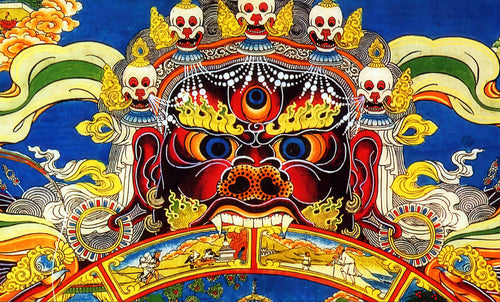
The 36 Lamedvovkins
Tzur TreviIt is a term from the Yiddish language, which has passed unaltered into the mystical Hassidic folklore of Eastern Europe. It is formed, as is evident, from the words Lamed and Vav (Ashkenazi pronunciation "vov"), the two letters of the Hebrew alphabet, with a "kin" ending that comes from Russian. In gematria these two letters are worth 30 for the Lamed and 6 for the Vav. Written in this way, they are also the way in which the number 36 is written.
In Hassidic mystical folklore, just as in the Toyreh (Torah) the Almighty held back from his decision to destroy Sodom, waiting for Abraham to bring him the Righteous Ones whom he claimed lived in the city, so even today the Eternal holds back from the decision to end the world, which is so far from the awareness of Tiqun Olam, for the sake of 36 extraordinary people, the Righteous and Wise Lamedvovkin, the Tzadikim so perfect in love and bitul of themselves that Gd Himself does not want, cannot interrupt them.
They are always 36 at every moment of the history of the World. Never one more, never one less.
If one of them passes away because it has reached the end of this life, immediately the Peqicha, the All-Seeing Eye, raises a new one to the condition of lamedvovkin, so that it can take its place.
Nobody knows who the 36 are. None of them is known by their identity, name and surname, such that they can be recognized and called Lamedvovkin and venerated with respect by ordinary mortals.
Each of them is completely unaware that he is one of the 36 and who the others are. Yet he is, and the others are, and they all work together miraculously and mysteriously in harmony, cooperating with each other to save and heal the world. Without knowing it.
Only the Name knows who they are; they have earned this position for themselves through their works and their sanctity and He has thus chosen them and elevated them to Himself.
If someone claims or declares, or confirms or lets others believe that he is a Lamedvovkin, well that is infallible proof that he is NOT a Lamedvovkin.
A few years ago a very famous Kabbalist here on social media, in a Kabbalah video, when asked by the interviewer, nodded and confirmed that he was one of the 36. I heard this statement and I suffered a lot of pain for his soul offended by his pride.
My master in the South of France even argued that it was very likely that, since the Tiqun Olam must involve all humanity in order to usher in the messianic era, then the Lord placed both Jews and non-Jews among these 36.
My master prayed, meditated and practiced, wrote books, translated them, printed them, bound them by hand, taught, attended to his shop advising customers and the curious, was the father of a large family and a loving husband. And he had guided the conversion of the local youth. And this was only in his free time. By day he was still a speech therapist.
And he told us that he suspected that one of his speech therapist colleagues, a Frenchman, a person he said was perfect and wonderful like no other he had ever met, perhaps, possibly, it could not be excluded that, was one of the Lamedvovkins.
And at that moment I knew I was in the presence of one of the 36.
I think the others thought so too. We all smiled gratefully. No one said anything.
"The essence of a thing is all in the first image it offers of itself"
(From the MA'AREKHET HA-ELOHUT, (Heb. מַעֲרֶכֶת הָאֱלֹהוּת ; "The Order of Divinity"), a systemic manual of Kabbalistic teachings by an unknown author, presumably composed in the 13th century. Printed in Florence in 1557.)
















































